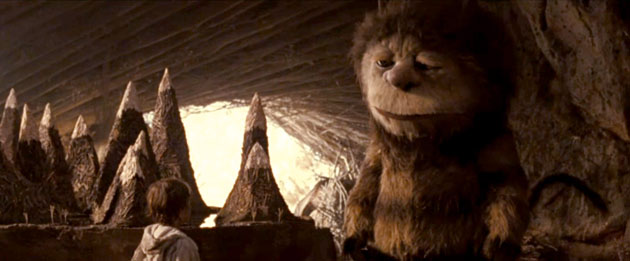K.K. Barrett

AS: Did the fantastic nature of Where the Wild Things Are feel very different from the other movies you’ve worked on?
KK: I went from Marie Antoinette to Where the Wild Things Are the next year. It was completely different. There are almost no props in Where the Wild Things Are, almost no set dressing. I just wanted big environments. I didn’t want tables and chairs or anything silly like that. I wanted to keep it about the internal neuroses of the characters. Every time you strip everything away what you leave behind is very, very important.
We didn’t leave nature alone. We modified nature quite a bit. We planted trees. We did a lot of things just to give it a little bit of specialness but to still keep it grounded. We changed seasons so it was spring and fall at the same time. We took all the green out of the movie. The first thing I decided was no green. Because everybody says, Where are you going for this? Are you going to the jungle? I had been looking at the forest and every time I was there I didn’t feel wild. I felt comforted. And it had no depth. Very shallow. By taking out green, the color everyone relates to healthy nature, it all of a sudden became more exciting to me. I’m sure there’s some green in there. But we made the decision to not have green and to have yellow and orange leaves instead when they showed up. You’ve already got giant people in half-fur and half-feathered costumes. You can mash up the outside world a little bit as well without having to go to CG.
AS: What was it like working with Sophia Coppola on Lost In Translation and Marie Antoinette?
KK: She’s very trusting. And very specific. With any director you just have to get in sync with their mentality. Their sensibility. What their sensibility for the project is and what their natural, inherent sensibility is. The sooner you figure it out the better off you are. She was very concerned about palette. And quality.
One thing that all the filmmakers I’ve worked with have in common, is they don’t want to make movies about other movies. They don’t want to reference other movies. They don’t want to have the design reference other movies. Every movie should be its own. And I think this is extremely important to production designers. You shouldn’t go into a Western by looking at Westerns. You shouldn’t go into a science fiction movie by looking at other science fiction movies. You can be aware of it but you shouldn’t take your table of contents from design work that someone else has done. It’s a wonderful chance to make it not like anybody else’s. Just decide what it can be. It’s such a great opportunity to create a vision and support a story and a cast. It’s just a missed opportunity if it looks like another dirty spaceship or another exact same type this or type that. Science fiction is probably the worst abuser of it, eating itself.
AS: Someone comes up with the idea of doing a dirty spaceship and then everyone’s doing a dirty spaceship.
KK: Yes, there was the original one, which might have been Dark Star, and then it’s the norm. But you know, make another norm.
AS: When you get hired on a movie and get a script do you end up watching a lot of movies for reference?
KK: I watch movies that probably don’t relate. Movies that maybe have the same emotional mood but that are not in the same genre. See how the mood affected the characters and how the mood that you settle on affects the characters. You could watch a Western for a romantic comedy, or a romantic comedy for something else.
Pingback: Grant Major